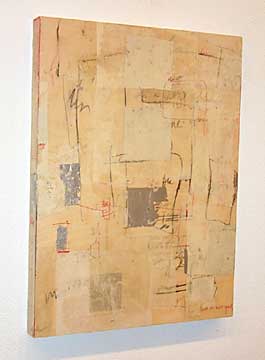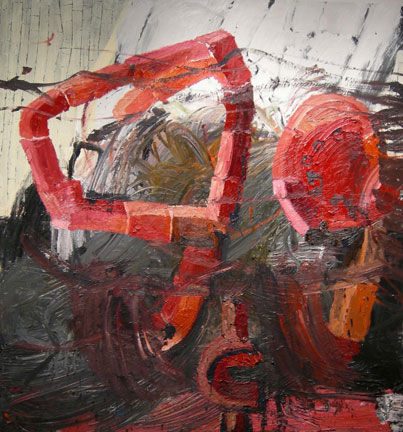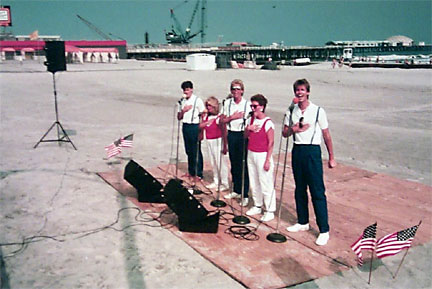 |
John
Salt
Untitled (Grey Auto) - 1997
casein on linen
43.5 x 65.25 inches (111 x 166 cm)
John Salt The automobile is the over-riding theme of John Salt's work. Moving to New York in the late 1960s, he was impressed by the sheer scale of the American cars which came to dominate his work. Obsolete, ugly and yet possessing a faded grandeur, he saw these cars as an intrinsic part of the U.S. landscape. Salt worked from his own photographs of wrecked cars which had been abandoned and left to rust alongside dilapidated mobile homes on the wrong side of town. With their crisp realism, the resulting paintings have the quality of a documentary photograph, recording the feeling of waste and ruin which has resulted from material prosperity. Latterly his work has become more romantic in spirit, featuring spacious suburban houses with their long verandas and parking lots under a soft covering of snow. A huge amount of skill and patience is involved in producing each work. A small painting takes about eight weeks to complete. The artist first makes a detailed drawing from slides which he projects onto the paper or canvas. Then, referring to a color print, he paints directly onto the drawing using an airbrush to achieve his sharp focus effect. For more detailed parts, such as branches and foliage, he cuts stencils through which he sprays. John Salt was born in Birmingham in 1937 and trained first at Birmingham College of Art and then at The Slade School of Art in London. When he arrived in the States he abandoned his early abstract style in favor of a more representational approach, soon becoming one of the most popular and significant artists of the American Photo-Realist movement. He has taken part in exhibitions all over the world including Canada, France, Italy, Germany, the Netherlands, Belgium, Switzerland and Japan. Excerpt from the exhibition brochure: "John Salt", Wolverhampton Art Gallery, UK, Marguerite Evans, April 1997.
 FRONT |
 BACK |
Marilynn Gelfman
Mother Nature and Blue Beard - 2000
mixed media
8.25 x 3 x 3 inches (21 x 7.62 x 7.62 cm)
Marilynn Gelfman BI-FRONTAL FIGURES AND THE TENACITY OF MEMORY Evocations of characters from nursery rhymes, fairy tales and old stories are constructed in pairs, connected back-to-back. Each figure is the obverse of its mated figural coin. Our first visual conjecture is based upon aural/oral voices from a collective past, a visual amalgam which continues throughout our lives, embracing later cultural icons. Each character reposes in a community of memories. In this exhibition, each figure has been released in dorsal connection with another persona, in a shared American expedition constructed of myriad objects that might have been discovered in Tom Sawyer's pocket. Marilynn Gelfman March 2000
 |
Ellen
Stavitsky
Birthday Piece - 1997
mixed media on wood panel
12 x 16 inches (30.5 x 40.6 cm)
Ellen Stavitsky Memory is the subjective selection of images and emotions. My work evokes particular moments from my life in which the essence is clear although the details are obscured. Combining Chinese joss papers, rice paper, book pages, oil stick, gouache, watercolor and graphite, I create compositions on wood, which suggest faint traces of past emotions and thoughts. To suggest underlying ideas, I make calligraphic marks or write actual phrases on the panels. As I add layers of paper and paint, the marks offer glimpses of past sensations. I am interested in subtleties which are not easily revealed, in secrets concealed and emotions contained beneath the surface. A framework for the residue of emotions left when memory is distilled, the pieces are repositories of meaning in my life. Ellen Stavitsky March 2000
 |
Shimon
Okshteyn
Untitled (Corkscrew) - 1999
graphite on canvas
32 x 22 inches (81.25 x 56 cm)
Shimon Okshteyn Shimon Okshteyn is undistracted. His work, his life, is focussed so obsessively, so tediously, so frighteningly, that it is almost impossible to see what he is doing. When you see his studio you may at first conclude that he is sitting surrounded by huge photographs, then you notice that his only materials are some pencils, no cameras, no lens, no film. Then you decide he is a madman. To take an object, mechanical perhaps, manufactured certainly, and then to render it in this fashion is such an extreme act, so chaotic apparently in intention that you fear for the creator. Your question of How? Is followed consistently by Why? Why indeed? The answer, maybe, is that Shimon wants to capture the essence, the form and vibration of an object. He wants to give dignity to the mass produced. To use this facility for this task gives nobility to the humblest safety pin or most intricate millinery. A safety pin is a wonder of this century, and Okshteyn is driven to reveal that. He wants, as he says himself, to make icons and for him these icons are all around us and unrecognized. His project is a Pop one - after all Warhol made the soup can an icon - but Okshteyn brings to his work a powerful sense of alienation and a genuinely fin de siécle character of lament and celebration. A sadness for the passing and glorious affirmation of human skill, drive and application, in his slow agonizing creations. This is a new kind of Pop Art. Engaging, shocking and baffling. Okshteyn's purpose is to focus the world around him through an intense engagement with these objects and let nothing distract him in their contemplation. He is after all pursuing a headlong, relentless and probably impossible task, but in this battle to represent, to illuminate this past, this history, his being undistracted is a gift to us all. From Shimon Okshteyn November 10, 1999 - January 7, 2000 Robert Sandelson Gallery, London, England
 |
Andy
Piedilato
"99 cent" - 2007
oil on canvas
92 x 86.5 inches (233.7 x 219.7 cm)
Andy Piedilato I work in a relatively traditional manner, oil paint on canvas. I paint primarily with my hands and interject with a brush occasionally to describe an edge or make a flat pattern. The image making begins with a figurative form (chest cavities, rib like or muscle like striations, tenuous forms) and often the illustrational qualities will be painted over, or elaborated on, or repeated to the point of abstraction. Painting over parts and repeating areas increases the possibility of finding new colors and forms. I find that this process attracts more specific color and form than if I tried to premeditate my image. I like to think that this process is "abstraction" but more importantly allows me to decide what is essential and needed from what is expendable. The paintings are completed quickly, one to two hour sessions maybe over two or three days. Some of the work is light and some are excessive or compulsive. Size is important to me; I work infrequently on a small scale, preferring to almost always paint between a six to eight foot range. Andy Piedilato Febuary 10, 2000
 |
William
Suttle
New Dawn Singers, Atlantic City, N.J. - 1995
chromogenic print
12 x 18 inches (30.5 x 45.7 cm)
William Suttle My intention is to describe a place. I don't know what I will shoot. Obviously I look for situations that I find visually compelling -- which are not always clear when they occur. And I am not entirely aware of what I've seen until the editing process. I photograph quickly, continuously for as long as a situation unfolds -- as long as I have to. I shoot a particular place over a long period of time -- months, even years. The editing process -- the choices I make of individual photographs in a series -- is the loading of proof upon proof -- photograph by photograph -- that this particular description is true. I aim for clarity. William Suttle March 2000
This web site was designed and created by REDRUM DESIGNS ©1999 OK HARRIS All Rights Reserved